
Beginners
Guide
to
the
Lotus Esprit
This guide is for those who have just discovered the Esprit and want to find out the basics, before trying to navigate the site for all the information. We will introduce you to the Esprit, right from it's first model, the S1 to the last model produced by Lotus, the late V8. We will also try to go over the basics of the car, from engines, chassis and wheels, to where the handbrake is. We will use links in this guide to help you find out everything and keep this guide a reasonable size. Click on the links, check the info and use the back button to come back to this guide.
Many versions of the Esprit have been released over the years for the worldwide market, we will be mainly talking about the major changes in the Esprits life.
Now where to begin! Are yes, the Silver Car. This was shown at the Turin Motor Show in 1972 and was the concept for the Esprit. The picture below show Lotus founder Colin Chapman with the car. The Cars body was design by Giorgetto Giugiaro and has a mid-engine (engine in the middle, just behind the driver) rear wheel drive layout. This was to last the life of the Esprit.
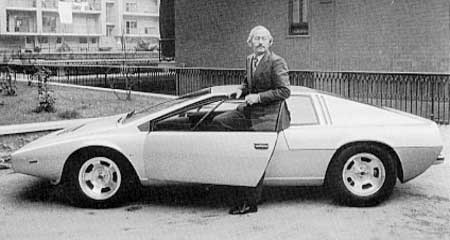
From the Silver car, production was held up due to different problems and the first Esprit, the S1 wasn't delivered to customers until 1976. The S1 was quite close in style to the Silver car. The S1 had a 130bhp 2.0 litre engine design by Lotus attached to a Citroen (Yes the French car company) gearbox.
c
It was also the Star of the James Bond movie 'The Spy Who Loved Me' (see pictures below) and is the reason for this site and many peoples attraction to the Esprit. It only appeared in one other Bond movie 'For Your Eyes Only' in which the Turbo version was used. The Esprit has also starred with Julia Roberts in 'Pretty Woman' and Sharon Stone in 'Basic Instinict' with both leading ladies getting to drive an Esprit SE.
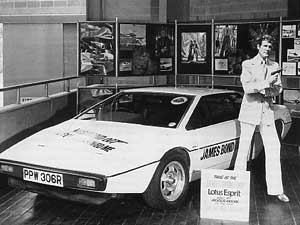




The S1 was replaced by the S2 in 1978, with only a few external & internal changes, it was basically a fix for all the S1's problems. Cooling being one of the bug bears. The S2 was followed in 1980 by the S2.2, which was basically an S2 with a 2.2 litre engine instead of a 2.0 litre. Very little else changed and with under 100 produced, they remain rare. As you can see from the pictures below, there's little difference between the S1, S2 and S2.2 (left to right). Lotus also released a special edition S2 in JPS colours (F1 Sponsor) to celebrate winning the F1 championship.
The next Esprit was the turbo in late 1980. This was a very different car underneath, including a new stiffer chassis, and looked slightly different due to a body kit. The first version of the Turbo was the Essex (One of Lotus' F1 sponsors). Carrying a 2.2 litre turbocharged engine and making 210 bhp. It was one of the quickest cars on the road, capable of over 150mph, leaving Ferrari and Porsche in it's shadow. The Turbo Esprit (it's proper title), was to run until 1987 with only minor changes made. In 1981 after the success of the Turbo Esprit, Lotus launched the Esprit S3, which used the new turbo chassis, but carried an un-turbocharged engine and lost the body kit. This is called an NA for normally aspirated, basically meaning no turbo. The S3 also ran until 1987.
G or S?
All the Esprit's above are commonly call Guigiaro Esprits, G Esprits or G-Cars. This separates them from the redesign of the body in 1987 by Peter Stevens (McLaren F1 designer). Esprits with the newer body are often called Stevens Esprits or S-Cars. Lotus coded the new body Esprit X180, so you may see them call an Esprit X180 as well.
The restyled bodied Esprit replaced the Turbo Esprit and S3 with the Esprit Turbo (note word swap) and Esprit NA. These cars were almost unchanged mechanically, but carrying a new Renault (yes, another French car company) gearbox that would now stay in the Esprit until production ended in February 2004. The Turbo and NA Esprit's are hard to tell apart. The easiest way is the Turbo carried a glass back. A piece of glass across the rear deck to aid cooling. Other differences are slight.
In 1989 Lotus released the Esprit SE (for Special Equipment), which was the fastest Esprit to date with 264bhp and a top speed of 165mph. The SE still carries the 2.2 litre, 4 cylinder, Turbocharged engine, but was now intercooled, using Lotus own Chargecooler. This allowed the engine to produce more power. The SE was also the first model to carry a rear wing, which makes it easy to tell apart from the more basic Turbo.
In 1993 another restyle was done in-house and the S4 was produced. This was the first Esprit to carry power steering, which would now be on every model released. Mechanically the same as the SE, this was an update to make the Esprit look more modern, with new bumpers, spoilers, wheels and interior. Can be easily spotted via its small wing, half way up the rear hatch. This was followed by a limited edition Sport 300, which was a race car for the road, based on a successful racecar used in America. The S4s was a mixture of the two, with an impressive 300bhp, still from the same 4-cylinder engine, this was released in 1995.
Lotus launched the Esprit GT3 in 1996. This was to be an entry level Esprit with no options as standard and only a 2.0 litre turbo engine (used before in European Esprits for tax reasons). With S4 wheels, a new modern interior and no wing the GT3 was defined by graphics on its sides. Light weight and well balance with 240bhp the GT3 became known as the Drivers Esprit. This was to be the last 4 cylinder Esprit.
Time for 8 cylinders!
In 1996 the Esprit V8 was launched and was the only model available. Basically it was an S4s with a new 3.5 litre, twin-turbo, V8 engine (8 cylinders instead of 4). Early V8 are hard to separate from the S4s, as they look identical expect for the badging. The V8 engine made 350bhp and had a top speed of 175mph. In 1998 the Esprit V8 got a new rear wing and a major interior overhaul. Lotus now offered two V8s, a cheaper V8-GT which came without a wing and other options and the fully loaded V8-SE. Both carried the same engine. 1999 saw the alloy wheels change on the V8's, from AWI to Saturns.
In 1999 Lotus released the Esprit Sport 350 with a limited run of only 50 cars. A track inspired car, with weight saving the main object. This would also be the most expensive Esprit ever at £65,000. With Magnesium wheels, a carbon fibre wing and AP Racing brakes, the Sport 350 is the ultimate Esprit. 2002 saw the final update to the Esprit. The Esprit V8 02 was basically a V8-SE for GT money. New wheels, rear lights and the Sport 350's brakes made the 02 quite a bargain. Production of the Esprit stopped in February of 2004.
30 years unchanged
Although the Esprit was developed over 30 years, the basics have remained the same from the S1 through to the V8 02. The Esprit is pure supercar, a two-seater, mid-engined, rear wheel drive sportscar. A pure driving machine. The Esprit is based around a galvanised (from 1980) steel backbone chassis, which means basically it's the piece everything bolts to, and is like a backbone, not a cage, like most cars. This remained basically the same throughout the Esprits life. The body is made of Glass Fibre with is light and strong, and of course doesn't rust! All Esprit are hand made on a production line. Put together piece by piece in true supercar fashion.
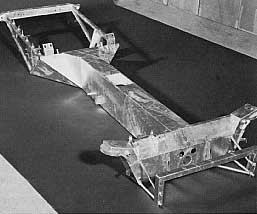
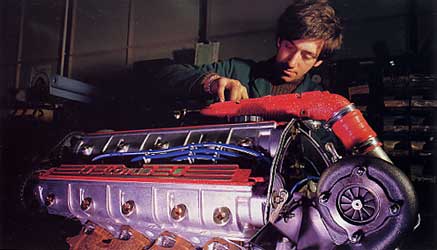
All Esprit engines have been designed and produced by Lotus from the first 2.0 litre to the mighty V8. Gearboxes on the other hand have been sourced from other manufacturers. G Esprit have Citroen gearboxes and S Esprits have Renault gearboxes. This was done as Lotus couldn't afford to buy the tools to make there own gearboxes due to the small amount of Esprit they would sell. They are also a bit of a weak point in the Esprit and will need looking after. Many other parts have been sourced from other car makers. Pre 1993 Esprits have many British Leyland parts and Post 1993 Esprit have many GM (Vauxhall, Opel) parts.
Esprits have always been produced in low numbers, making them rare on the roads. Over the 27 years the Esprit has been in production under 11,000 have been built for the world wide market. In contrast, Porsche produce 23,000 911's (2001 figures) in one year, double the amount of Esprits ever made. Why aren't they rarer? Because people love them and look after them and if someone doesn't want it any more, someone else will take it off their hands and restore it. Keeping more and more Esprits on the roads.
Driving & Running One!
(see buying & running guides here)Firstly driving one. Due to its shape you'll find the driving position feels like you're lying down compared to other 'normal' cars. Watch the handbrake as you get it. It's down on the sill by your ankle. You'll find the forward visibility pretty good and only restricted by how low down you are. Rearward visibility is poor with just a pillar box slit to see out of. The wing mirrors are of great help. If you are driving a pre 1993 Esprit, you'll have no powersteering, so moving around at low speeds will be a bit of an effort (especially if you've left the handbrake on, as most new drivers do). The pedals can be a problem for those with larger feet, as they are set close together. First time drivers normal end up hitting the accelerator as well as the brake when trying to slow down. You may also find the brakes to be much less servo'd than modern cars, so you'll need to push that bit harder. Reverse can be difficult to select sometimes, so slot it into first, then reverse.
Once moving you'll experience what the Esprits all about. Difficult to explain, but once you feel the surge of power and have taken your first sweeping corner, you'll know what I mean. Two things to remember that will help you look after the gearbox. Never leave your foot on the clutch while in traffic, select neutral while stationary. This takes the strain off the clutch, also double-declutching on down changes will make changing gear easier and reduce wear. Do this by using the clutch to select neutral, then again to select the gear down.
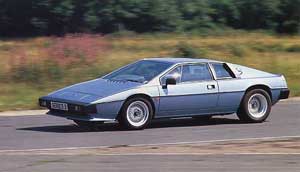
Once you've finished, remember the handbrake again! If you're wanting a peep at the engine the rear hatch lever is behind the drivers shoulder. One pull and the engine bay will be open. All Esprits have some type of engine cover, which will have to be removed to see the engine. You'll also find quite a large luggage space for a supercar. If you want more, buy something else! If you're interested what's up front, where the engine should be. The front hatch lever is under the front dash. Feel around among the wires and you should come across what feels like a coat hanger. Pull this towards you to release the front. On closing, push the front back down and push the lever away from you, you should hear it catch. Under the front, you'll find the spare wheel, jack, window washer bottle and a few of the Electrics.
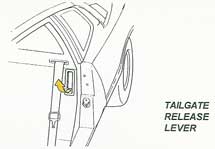
Running an Esprit can be both joy and pain. Depending on the condition of the car, will depend on how much of each you will get. People tend to think of Esprits as less of a supercar when it comes to looking after them. Your Esprit will need as much care and attention as the most expensive Ferrari's or Lambo's. More if you consider that an Esprit is likely to be used more than most supercars.
They will need regular servicing and parts replacing now rather than later. Some parts are expensive, some are reasonable, but expect to spend quite a bit maintaining your Esprit. If you don't then you could be looking at bigger bills. All fluids will need regular checking and topping up, as will all other consumables. They aren't difficult to look after, they just need looking after.
If you think of anything relevent that could be added to this beginners guide. Please email us at admin@lotusespritworld.com
|
|